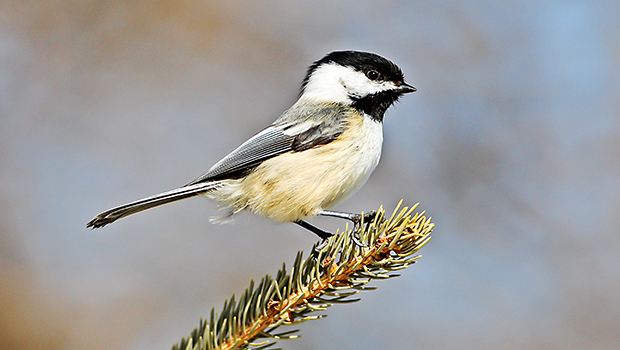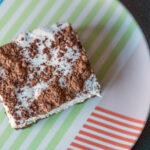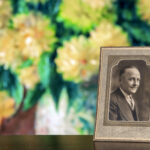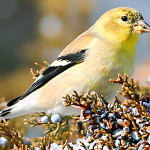

The Northeast South Dakota Birding Club Embraces the Season.
The Northeast South Dakota Birding Club doesn’t let the frigid temperatures and deep snow of South Dakota winters stop them from doing what they love. Gary Olson, Aberdeen’s NSDB club president says birding is one hobby that is thoroughly enjoyable year round. Gary’s interest in birding began when he was about 12 years old, “I saw a Baltimore Oriole in the trees.” He became mesmerized by the intrinsic beauty of these majestic creatures.
Then later, when Gary met his future wife Cindy, he found out that she too shared his passion for birds. So when Gary retired from 3M after 36 faithful years of service, he decided it was time to get serious about his lifelong fascination. “I had been asked several times, by a fellow bird watcher Eve Larson, if I thought there was any interest (locally) in forming a bird club.” Gary decided to find out. He sent a group email to friends he knew were also avid birder watchers and he received an overwhelmingly favorable response. Thus, the NESDB club was formed. The original members being Gary himself, along with other local birders including: Eve Larson, Dan Streifel, Alyssa Anderson, Nate Roberts, Al and Tammy Olson, Brian and Joyce Kringen, Terry and Geri Jordre, Barry Parkin, Matt Henning, Chad Peterson, Val Veland, Tracy Rosenberg and Cecilia Storley. “These are all the folks I can recall being at the first meeting, but I’m sure I’m missing a few,” Gary states.
The Northeast South Dakota Birding Club goes on regular birding outings, even in the coldest of months. What makes watching snowbirds enjoyable for Gary in the winter months is the chance to spot rare migratory species he’s never seen before, as well as the opportunity to ensure our local species are thriving. “I also enjoy when I think I’ve figured out when or where I’ll see a particular specie, then they will surprise me and appear at a different place or time.” Gary also enjoys noticing how the the number of a particular species he sights fluctuates from year to year.
Gary says the NESDB club’s mission is simply: “To get out and enjoy birding and nature.” They have bird feeders set up at both Richmond and Mina State Parks to provide others the opportunity to enjoy birding. Before their outings, the club meets once a month on the second Saturday, usually from 8 a.m. to 12 p.m. at the Senior Center, and more frequently during migration or peak birding times. The information gathered on club outings is reported by Gary on the South Dakota Ornithologists’ Union website at www.sdou.org.
Gary picks the NESDB club’s outing location. He had been birding several years prior to the formation of the club. As a result, he has learned which birds are likely to be found in various habitats. Locations the birders club has visited so far include: the site of former Blue Cloud Abby, Sand Lake National Wildlife Refuge, Ordway Prairie, Mina, Richmond Lake (Forest Drive), Hartford Beach State Park, Sica Hollow State Park, Lake Hiddenwood Recreation Area, Riverside Memorial Cemetery and the bike path along Moccasin Creek near the public swimming pool. A variety of habitats such as marshes, prairies, forests, and even neighborhood yards have been utilized on club outings. All the bird species seen are put into the SDOU database so there is a historical record that can be used later for reference. It’s important to have a record of birds spotted that are not only out of their normal range but also a record of whether or not the ones normally seen in our area are doing well.
January is when the The Northeast South Dakota Birding Club holds their annual business meeting. Gary sends emails out to the current 20 members. He also posts club information on Yahoo Groups under SD-birds. That list reaches about 477 members. Any new idea or new project is discussed. Officers are elected every other year so it will be a year from now before they elect again. “We collect no dues so projects are run on volunteers and donations.” At this year’s meeting, they will review last year’s sightings and watch a small presentation on Whooping Cranes. “The club was lucky to see a pair of Whooping Cranes on our first outing this past April, so a little history should be interesting for all.” In addition, Brad McDonald (one of the club’s newest members) has written a book about his birding adventures and will be giving a presentation on his birding adventures. The club will discuss possible outing destinations for this year, along with plans to work on some combined outings with the Sioux Falls Birding Club. This year’s annual business meeting will be held on January 10 at 1 p.m. at Northern State University. The building and room will be announced at a later date. Interested parties should contact Gary Olson, Northeast Birding Club President, by leaving a message at (605) 225-5241 or by emailing him at [email protected].
- Be sure to dress in appropriate winter clothing. Wear layers and be sure to cover all exposed skin, especially your ears, neck, and face. Choose clothing that is wind-resistant yet breathable, and cover your hands with gloves that allow for both grip and dexterity. Protect your feet against frostbite, and prepare yourself for varied terrain with wool socks and waterproof footwear. Clothing well suited for winter birding can be found at local sporting goods stores such as Dunham’s and SODAK Sport and Bait, and some articles may be purchased at local department stores.
- Invest in a quality pair of binoculars. Be sure to purchase binoculars with a strength of at least 10 X 42 mm. These will provide adequate magnification power. That, combined with a sufficient objective lens diameter, will give you the most out of your birding experience. Get your high-powered binoculars at any local sporting goods store, or the sporting goods section of Walmart.
- Purchase user-friendly identification books. Two excellent books are Birds of the Dakotas Field Guide by Stan Tekiela (which helps the novice birder to identify birds by color) and Birds of South Dakota by Dan A. Tallman, David L. Swanson, and Jeffrey S. Palmer (an easy to follow and locally created fielder’s guide).
- Become familiar with your field guide. After studying a reputable bird guide, you will know what birds you can expect to see and where you can expect to see them. Birds that frequent our area in the winter months, such as the American Goldfinch, can be found in a variety of habitats. Use your field guide to save yourself time and frustration, so your birding experience can be as fulfilling as possible. Successfully referencing your guide while you still have the bird in sight is nearly impossible. Study the details of the bird you have in sight, then when the bird flies away, get out your guide to help you identify the specie. Some details to look for are: body color, wing bars, eye-rings, the length from tail to wing tips and foot color.
- Know where to look. Typical winter birding habitats include feeder stations, forested areas and fields. To spot birds during this time of year, drive country roads and keep an eye out in the ditches where you may sight small birds going across the road and out into the fields. Also, walk Richmond and Mina Lakes trails. A walk along Moccasin Creek bike trail can also turn up something interesting but is usually a better spot to visit during migration season. Cemeteries can be ideal birding locations. Gary has had quite a bit of luck finding winter birds in and around the Riverside Cemetery. You may even be so lucky as to see an Arctic breeding bird starting its winter molt back into breeding plumage. Plain brown winter birds can molt into colorful little diamonds. Gary hops to lead a late winter trip to the Hartford Beach area along the Minnesota border, or perhaps a trip to Lake Hiddenwood nearby Selby.
- You can even attract birds to your own backyard. Encourage backyard bird sightings by considering the elements needed in a natural bird habitat. Specific elements vary from bird to bird, but some basic features in any bird habitat are a mixture of flowering and nonflowering plants, trees and bushes with consideration to the specie’s needs for shelter and roosting. In addition, be sure to research which feed is appropriate to the species you’re attempting to attract. Keep in mind the importance of effective protection and dispensing of feed. Bird feeders are designed to keep larger birds or squirrels from invading the food supply. Certain feeders are also designed to dispense specific types of seed that attracts birds in the winter. Sunflower seeds and suet (hard animal fat) are low cost and appropriate. This type of feed is preferable over the typical seed blends seen on store shelves (which is better suited to spring-fall birds) as it contains the additional fat needed by winter birds to keep them well-insulated. Both feeders and seed can be purchased at local supply stores such as Running’s or Tractor Supply Company. // by Barb Andrews
- Horned Lark Seen year-round in open country as it is a common migrant
- Purple Finch Seen only in winter Residential areas
- Bohemian Waxwing Seen only in winter in woodlands, residential areas with fruit trees and shrubs
- American Goldfinch Seen year-round in residential areas
- Pine Grosbeak Seen mostly in coniferous forests, and fruit trees




















